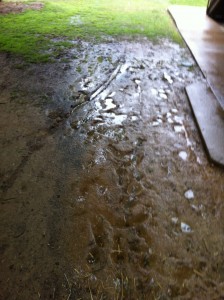Every soil can benefit from the use of mulch or an organic covering on top of them. 
When I first arrived at East Fort Worth Montessori Academy, the alley to the chicken coop is sandwiched between the building and the sloping hillside that feeds the alley with a downpour of water. The soil in the alley has cracks and quickly absorbs and holds water, a good indication of a good heavy clay soil.
The first rain showed the signs of a good mucky clay.
 To alleviate the issue, we decided to obtain some free mulch and spread it over the soil. A good three inches will do the trick. The transformation after is unbelievable. A place that was once a trap to walk through can become functional once again.
To alleviate the issue, we decided to obtain some free mulch and spread it over the soil. A good three inches will do the trick. The transformation after is unbelievable. A place that was once a trap to walk through can become functional once again.
In the years of using mulch, the pattern emerges that the soil that feeds us needs more organic matter and love. It’s truly a universal solution to build soil and ourselves. Reflecting on the theme of this blog, to cultivate ourselves we must take care of the elements that nurture and feed our body and soul, the soil and all the life within it. The result is a mirror image of ourselves in nature. The soil is now ready for cultivation and growth. 



